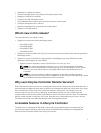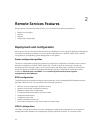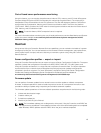
• Deploy operating system on iSCSI and FCoE LUN.
Near Field Communication (NFC) using the QuickSync feature
Using the QuickSync feature, you can:
• View basic server information such as Service Tag, MAC address, NIC data, firmware versions,
operating system, and so on.
• View log and monitoring information of a server.
• Configure network parameters of a server.
After viewing or editing the information, you can troubleshoot or configure using a mobile device. To use
this feature, you must install the OpenManage Mobile (OMM) software application on your mobile device
and enable the bezel on the server. The QuickSync feature enables your mobile device to act as a
proximity reader which reads data on the server when held at a distance of less than 20 mm from the
server front panel. You can perform most of the tasks that you complete by using an LCD panel. The
system information is the basic hardware inventory information retrieved from NFC. The attributes allow
you to set the access, check the presence of QuickSync feature, enable or disable the Inactivity Timer, set
the inactivity timeout value.
NOTE: This feature is supported only on Android mobile devices.
For more information on the QuickSync feature, see the System QuickSync profile document available at
en.community.dell.com/techcenter/systems-management/w/wiki/1906.dcim-library-profile.aspx.
Also, see iDRAC User’s Guide available at dell.com/esmmanuals.
Configuring advance security using hash password
You can set user passwords and BIOS passwords using a one-way hash format in iDRAC available on the
13th generation Dell PowerEdge servers. The user authentication mechanism is not affected (except for
SNMPv3 and IPMI) and you can provide the password in plain text format.
With the new password hash feature, you can:
• Generate your own SHA256 hashes to set iDRAC user passwords and BIOS passwords. New attributes
are created to represent the hash representation of the password.
• Export the Server Configuration Profiles file with the password that has the hash values. To do this,
use the ExportSystemConfiguration method and include the password hash values that should be
exported to the IncludeInExport parameter.
The hash password can be generated with and without Salt using SHA256. Whether the Salt string is used
or null, it should always be set along with the SHA256SystemPassword.
NOTE: If the iDRAC user account’s password is set with the SHA256 password hash
(SHA256Password) only and not the other hashes (SHA1v3Key, MD5v3Key), authentication through
SNMPv3 is lost. Authentication through IPMI is always lost when hash is used to set the user
account’s password.
For more information on using hash password, see the iDRAC Card and BIOS and BootManagement
profile documents available at en.community.dell.com/techcenter/systems-management/w/wiki/
1906.dcim-library-profile.aspx.
15


















